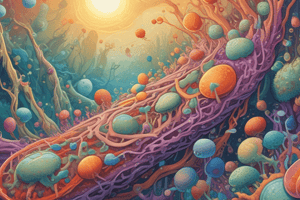Podcast
Questions and Answers
Which concept is best illustrated by the diagram of a single-celled organism?
Which concept is best illustrated by the diagram of a single-celled organism?
- Single-celled organisms carry out life functions that are essential for survival. (correct)
- The life functions performed by a single-celled organism are different from the life functions performed by complex organisms.
- Single-celled organisms contain one organelle that performs all the life functions.
- Since single-celled organisms lack organs, they can survive only in moist environments.
Bacteria and humans are similar in that they both:
Bacteria and humans are similar in that they both:
- are single-celled
- contain genetic material (correct)
- lack cell organelles
- carry out autotrophic nutrition
Which statement concerning organism A and organism B is correct?
Which statement concerning organism A and organism B is correct?
- Organism A and organism B both have structures that perform life processes. (correct)
- Organism A and organism B have the same organ systems.
- Organism A contains organs, whereas organism B lacks organs.
- Organism A lacks structures that help maintain dynamic equilibrium.
Which of the following pairs of species are most distantly related?
Which of the following pairs of species are most distantly related?
Which two organisms are the most closely related?
Which two organisms are the most closely related?
Which letter or letters represent an animal that could be a coelenterate?
Which letter or letters represent an animal that could be a coelenterate?
Which scientist is correctly paired with his contribution to biological science?
Which scientist is correctly paired with his contribution to biological science?
In the binomial system of nomenclature, which two classification groups provide the scientific name of an organism?
In the binomial system of nomenclature, which two classification groups provide the scientific name of an organism?
Which organism in the chart is most distantly related to the other organisms?
Which organism in the chart is most distantly related to the other organisms?
Flashcards are hidden until you start studying
Study Notes
Classification of Organisms
- Single-celled organisms perform essential life functions necessary for survival.
- The life functions of single-celled organisms differ from those of complex multicellular organisms.
- Single-celled organisms, despite lacking complex organs, can thrive in moist environments.
Similarities Between Organisms
- Both bacteria and humans are characterized by the presence of genetic material.
- Not all bacteria are single-celled; humans are multicellular and do not lack cell organelles.
Organism Structures and Life Processes
- Organism A (single-celled) and Organism B (multicellular) both possess structures necessary for carrying out life processes.
- Organism A does not contain organs, but both organisms have mechanisms that support life functions.
Relational Distance Among Species
- The dog and bacteria represent the most distantly related pairs of species in a given comparison.
- Closer relationships are observed among species like humans and dogs or giraffes and squirrels.
Closely Related Organisms
- Based on a classification chart, organisms B (Felis domestica) and C (Canis lupus familiaris) are the most closely related.
- Organisms A (Musca), B (Canis), and C (Felis) belong to the Animalia kingdom but differ in specific classification features.
Coelenterates in the Animal Kingdom
- Animal B, characterized by a saclike cavity, may represent a coelenterate as it possesses both intracellular and extracellular methods of digestion.
- Organism classifications can vary according to their digestive structures and methods.
Contributions to Biological Science
- Carl Linnaeus is known for creating the binomial system of nomenclature to name organisms.
- Other notable scientists are incorrectly paired with unrelated contributions, such as Darwin and the invention of the electron microscope.
Binomial Nomenclature
- The binomial system for naming organisms uses the genus and species classification groups.
- This system provides a unique scientific name that identifies an organism’s specific classification.
Distinctly Related Organisms
- In a classification chart, the plant organism (Organism A) is the most distantly related compared to other animal organisms (B, C, D).
- The classification reveals clear distinctions among kingdoms, highlighting the diversity of life forms.
Studying That Suits You
Use AI to generate personalized quizzes and flashcards to suit your learning preferences.




